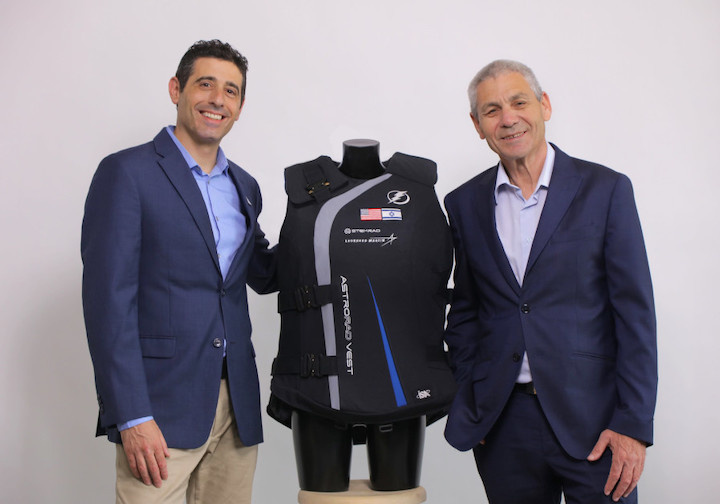StemRad CEO Dr. Oren Milstein (L) and Israel Space Agency director-general Avi Blasberger with the AstroRad radiation protection vest. (photo credit: STEMRAD)
radiation protection vest developed by Tel Aviv-based StemRad blasted off toward the International Space Station (ISS) on Saturday on-board a robotic resupply spacecraft launched from NASA’s Wallops Flight Facility in Virginia.
StemRad’s AstroRad vest offers personal protective equipment for astronauts to wear beyond low Earth orbit, mitigating space radiation exposure outside the Earth’s magnetosphere.
Developed in partnership with the Israel Space Agency (ISA) and Lockheed Martin, the vest will travel on the Cygnus NG-12 resupply flight to the ISS, together with 4,000 kg. of station crew supplies and scientific cargo.
The AstroRad vest will undergo a series of tests and ergonomic experiments on the ISS, orbiting 400 km. above Earth. The company adapted its vest for women, who are particularly vulnerable to space radiation. It will be tested by three female American astronauts in micro-gravity for variable durations and during routine activities.
Under an agreement between the ISA, NASA and German Aerospace Center (DLR), the research represents an important step ahead of launching the AstroRad radiation protection vest aboard NASA’s unpiloted Artemis-1 mission around the Moon in late 2020 or early 2021, the last test flight before NASA begins manned deep space missions.
“The success of the AstroRad trials will constitute a critical contribution from the State of Israel to NASA’s most ambitious research program since landing on the moon,” said StemRad CEO Dr. Oren Milstein.
“Thanks to the collaboration between a number of professional and governmental bodies, led by Lockheed Martin and the Israel Space Agency, we are very close to a proud achievement for our space industry and the entire State of Israel.”
Bringing the Israeli flag to the ISS for the first time, the AstroRad uses a proprietary smart shielding design to selectively protect organs and tissues which are most sensitive to radiation exposure.
Should the tests prove successful, AstroRad could be a critical part of NASA’s space exploration plans for years to come, including the establishment of a sustainable human presence on the Moon and later sending astronauts to Mars.
According to StemRad, the results of experiments conducted on the ISS, together with data obtained during the Artemis-1 mission, will provide NASA will all the information necessary to evaluate the vests as an effective tool for protecting astronauts from fatal radiation in deep space missions.
All human space exploration missions to date, except for the Apollo moon landings, have been restricted to low Earth orbit (within 500 km. of the Earth’s surface), where the Earth’s magnetic field protects astronauts from most space radiation threats, including deadly solar storms and galactic cosmic rays.
“We are breaking Israeli records of activity, creativity and initiative in all areas of science, and in space in particular,” said Science and Technology Minister Ofir Akunis. “I am proud of the developers of the first Israeli space suit.”
Also aboard the spacecraft is be the Zero G Kitchen Space Oven, designed by Ian and Jordana Fichtenbaum of New York. The oven is an insulated container designed to hold and bake food samples in the micro-gravity environment of the ISS.
Their prototype oven – together with a batch of cookie dough from DoubleTree by Hilton – will enable food to be baked in orbit for the first time. Built in collaboration with NanoRacks, a provider of commercial access to space, the couple aims to make space travel more comfortable for astronauts spending months on-board the ISS.
Since convection heat transfer is difficult or impossible in zero gravity, the oven relies on electric heating elements similar to that found in a toaster oven. The device is powered by electricity drawn from the ISS’s internal power system.
The oven can be adapted to provide grilling, pan cook and griddle modes of cooking, all in a micro-gravity environment.


